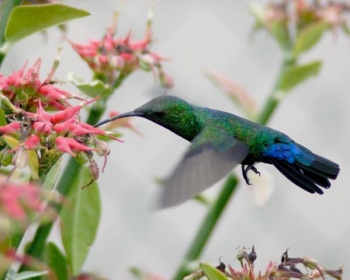- Eulampis holosericeus
Identification
10.5-12 cm, with little or no difference between sexes.
Upperside is green with blue outer uppertail coverts but green central uppertail coverts; sometimes, a bluish sheen can be seen on outer tail feathers. Underside has an iridiscent green throat and upper breast, followed by a narrow blue band, and the rest of the underparts are black. (Whereas the iridescent areas on some hummingbirds looks black in some angles of light, the throat area of the Green-throated is always green regardless of the light). The bill is black and somewhat down-curved. In Dominica some individual birds have single white feathers or even a white spot around the leg.
This is one of the species of hummingbirds where one sometimes will see a bird with part of the plumage colored by the pollen from a flower. Examples include a bird with the crown having an oval yellow area, and different birds with yellow instead of green throat area.
Distribution
Endemic to the Caribbean where it is found from Grenada north throughout the Lesser Antilles and into Puerto Rico of the Greater Antilles.
Taxonomy
Subspecies
There are 2 subspecies[1]:
- E. h. holosericeus:
- Puerto Rico, Virgin Islands and Lesser Antilles (except Grenada)
- E. h. chlorolaemus:
Habitat
Rainforests, gardens, and other places with flowers at all elevations.
Behavior
Diet
All Lesser Antillean Hummingbirds will take insects in addition to feeding on nectar.
References
- Clements, J. F., T. S. Schulenberg, M. J. Iliff, D. Roberson, T. A. Fredericks, B. L. Sullivan, and C. L. Wood. 2014. The eBird/Clements checklist of birds of the world: Version 6.9., with updates to August 2014. Downloaded from http://www.birds.cornell.edu/clementschecklist/download/
- Handbook of the Birds of the World Alive (retrieved January 2015)
- BF Member observations
Recommended Citation
- BirdForum Opus contributors. (2025) Green-throated Carib. In: BirdForum, the forum for wild birds and birding. Retrieved 7 April 2025 from https://www.birdforum.net/opus/Green-throated_Carib
External Links
GSearch checked for 2020 platform.1






